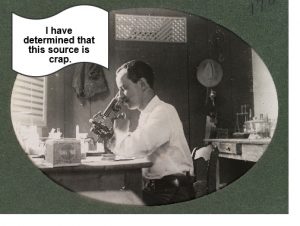Tell me if this sounds familiar: You’re searching online for sources for your research paper, and halfway through reading, you ask yourself, “Who writes this crap?”
Good question.
You, your neighbor, or just about anyone can publish online. In the world of the internet, you could become Allie S. Everson, PhD and write an article titled “The Evolution of String Theory: Are Scientists Stringing Us Along?”
Sounds credible, right? All you need to do is write a really good summary of what you can dig up on Wikipedia and bam—you have an article!
The problems with this are pretty obvious. First, you’re likely plagiarizing another source to write your article. And second, you’re claiming you hold a PhD.
Another problem is that some unsuspecting student might be citing your bogus article in a research paper.
You could easily fall victim to bogus “experts” too, if you don’t carefully choose your sources.
So how exactly do you decide if a source is crap? Simple: Apply the CRAAP Test!
(Yes, really. CRAAP Test. That’s really what it’s called.)
The test helps you determine whether your sources are crap, so keep reading to learn how to use it.
What Is the CRAAP Test?

The CRAAP Test is a series of questions to help you decide whether a source is credible.
It’s like evaluating all the elements that make up a source through a microscope. You need to look at all of its parts to determine whether it’s appropriate for your research essay.
CRAAP stands for “currency, relevance, authority, accuracy, and purpose.” You’ll need to examine each one of these components to decide whether a source is crap or whether it’s worthy of inclusion in your research paper.
Applying the CRAAP Test to Your Essay Sources
When you’re completing research, you don’t want to use every source you find. You also can’t just assume that all sources are created equal.
Sure, you’ll save a lot of time by choosing the first five or ten sources that appear in your search results. But it’s not likely that they’ll be the best (or most appropriate) sources for your paper.
Why?
Because when you research, you’ll encounter many sources that are, in fact, crap (especially if you’re doing all of your research online using only websites).
To determine what’s useful and what’s not, test your sources by asking the questions listed under each of the following categories.
CRAAP Test: Currency

In this case, currency has nothing to do with money. Here, currency refers to the timeliness of the source. In other words, when was it written?
Unless you’re critiquing a specific source or you’re using it for a historical overview, you’ll want to find the most recent information possible.
If you’re citing a website, it might not be that easy to find the date the source was originally written. But you should be able to find the date the information was last updated. Check the bottom of the webpage for a date when the information was created or last updated.
Think the date of a source can’t really mean that much? Think again.
Let’s say you find a source online (written five years ago) about a breakthrough cancer treatment. A five-year-old source may not be that old for some topics. But in the world of science and technology, five years might as well be a lifetime.
That breakthrough cancer treatment of five years ago might have already been deemed unsafe, and several new breakthrough treatments might now be in place.
CRAAP Test: Relevance

This may sound a bit too obvious, but you’ll need to ask yourself whether the source is relevant to your research.
Just because you’re writing a paper about minimum-wage laws and the title of the article includes the words “minimum-wage laws,” you can’t automatically assume the content of the article meets your needs.
The article might explain the reasons that minimum-wage laws were created. But if you’ve already located a source about the history of the law to use as background information, the article may not provide any new or useful information for your paper.
You’ll also need to think about the intended audience and whether the source is written at an appropriate level.
If, for example, the source is written for middle school students and you’re writing a college research essay, you can pretty much assume your professor won’t be too happy seeing the source on your Works Cited or References page.
Don’t assume that scholarly resources will always be written for the appropriate audience, either.
If you’re writing a paper about mental illness and you’ve located a research paper written by doctors for doctors, you might become a bit lost. If the paper is written for other doctors, the authors have likely used terms and explanations that you simply won’t understand.
You should skip these types of articles too. If you can’t make sense of the information, you certainly can’t use it as a source in your paper.
CRAAP Test: Authority

I have it on good authority that evaluating the authority of a website means more than simply locating the author of the article or site.
Knowing the name of the author doesn’t do you much good if that’s all you know.
Start your review of the site’s authority by looking at the author’s credentials.
Does the author have a degree in the field? Does he or she work in the field? Has the author written other articles or books about the subject?
NOTE: Someone having written about a subject or published a book about a subject doesn’t automatically mean that he or she is credible.
A self-proclaimed “healer,” for instance, isn’t as credible as an MD (doctor of medicine) if you’re researching new medical treatments.
Next, consider the type of source you’re reviewing and whether it’s appropriate for your needs.
If you’re researching opinions about the newest iPhone, reading blogs and forums written by just about anyone might be useful.
On the other hand, if you’re researching the topic of global warming for your essay, reading sources written by just about anyone is definitely not recommended.
When you’re evaluating the authority of a web source, remember to look at the URL. A .com site is more likely to simply want to sell you something. A .gov or .edu site will likely present more in-depth and balanced information. A .org site may contain detailed information, but it may have an agenda and may be biased.
You’re looking for clear, accurate, unbiased, and well-documented sources. Usually, this means avoiding .com sites. (News websites, such as CNN.com, NYTimes.com, or NPR.com are generally exceptions to this rule.)
Looking for help finding credible sources online? Read 5 Best Sources to Help With Writing a Research Paper.
CRAAP Test: Accuracy

Does this source hit the mark? Is the information correct?
Before you decide whether you want to use the source in your essay, check to see whether you can verify the information.
If one source states 75% of college students don’t bother to purchase the required textbooks for their courses and another source states roughly 10% of students don’t purchase textbooks, look to see how the statistics were gathered and try to verify which source is correct. (Keep in mind, you may find a third source that presents yet another statistic, so you may need to continue to research to verify accuracy.)
Next, read carefully to make sure the author uses ample evidence to support claims.
If a source claims 50% of all teens with valid driver’s licenses receive at least one speeding ticket before they reach the age of 20, does the author support this claim with verifiable, statistical evidence? Or does the author just make up random statistics to support that argument?
The final step in checking accuracy is to examine the author’s arguments. Is the information balanced, or is it biased? A biased source contains only one side of the argument, likely with little evidence to support claims.
A Note About Appearances: If you’re reading an anonymous source with multiple spelling and typographical errors, it’s pretty easy to figure out that the source might not be credible and that the information might not be accurate. But sometimes non-credible websites appear to be professional. Don’t be fooled by a slick-looking website.
To learn more, take a look at Evaluating Websites: What You Need to Know to Find Great Sources.
CRAAP Test: Purpose
No, don’t spend your time now asking what’s the purpose of writing a research paper. (That’s a conversation for another time.)
Now is the time to ask why your potential essay source was published.
Was it written to inform readers? Does it use fair, unbiased language? Or is the purpose to persuade? Does the author use persuasive or manipulative language to convince readers?
Again, this is especially important when evaluating websites. Does the website exist solely to sell you something? Is it trying to promote a political or religious agenda?
If the source is biased and attempts to promote a specific agenda, it’s probably not your best bet for a research essay (unless, of course, your paper intends to evaluate the article and examine the bias and propaganda in the source).
Now that you know what the CRAAP Test is, let’s apply it to an example assignment.
A Sample CRAAP Test
For the purposes of this CRAAP Test, pretend you’re writing an argumentative essay about animal abuse and testing.
Should you cite the website People for the Ethical Treatment for Animals (PETA) in a formal, research-based argumentative essay?
Let’s put PETA to the test. (Don’t worry—no animals will be harmed in this experiment.)

Currency
When you check the bottom of the homepage, you’ll notice that the page lists the current year as a copyright date.
Feature stories as well as news stories are current, with publication times as recent as 23 hours ago.
Clearly, PETA keeps its site up to date and provides current information.
Relevance
PETA’s entire focus is animal welfare, as pointed out by the following mission statement: “Animals are not ours to experiment on, eat, wear, or abuse in any other way.”
If you’re arguing that animal abuse and testing needs to stop, PETA provides plenty of information to review. It’s safe to say that PETA is a relevant source.
Authority
PETA includes a “PETA People” section that lists various staff members and executive board members.
Listing employees’ credentials helps to increase the credibility of the site as this illustrates that writers are capable and qualified to write about the topic of animal welfare.
Accuracy
Though PETA contains a number of news articles, most of these articles are written only in support of PETA’s activities, making much of the information biased.
While the articles may appear to contain credible information about world events (like the UK banning wild animals in circuses), there are few (if any) links to additional outside sources to help verify information.
Because PETA rarely links to outside sources, the information is presented only from PETA’s point of view. This makes it difficult for the average reader to know how much of the information is accurate.
If you’re not sure that a source is presenting accurate information, your next step in evaluating the source is to see if the information is published elsewhere.
In the case of the UK banning wild animals in circuses, you can easily find a government website to verify that such legislation has been introduced.
But what about the accuracy of the other information presented on PETA’s website?
A quick online search about PETA uncovers a slew of negative articles and websites that attempt to highlight the supposed inaccuracies and lies promoted by PETA.
Search results contain a number of opinion pieces (like this one from Vassar College) and websites (like this one) that are in favor of abolishing PETA and attempt to expose “the truth.” (Remember, not all sources are credible, and some of these sources will likely fail the CRAAP Test.)
Within the search results, however, you’ll also find credible blogs, op-eds, and articles from respected sources, such as HuffPost and The Atlantic. And it’s those credible sources that will make almost any reader question the authority of PETA and its usefulness as a research source.
Purpose
The purpose of PETA is abundantly clear: to persuade.
PETA’s goal is to convince readers to support its cause and get every reader to contribute to the organization. For instance, PETA heavily promotes its agenda through continued pop-ups asking readers to donate.
PETA also favors emotional appeals as it attempts to persuade readers through graphic pictures of testing, sad animals in cages, and happy, adopted animals. PETA also uses persuasive and manipulative language in an effort to convince readers.
The final evaluation of PETA
While PETA is a widely known organization whose website contains a great deal of information against animal testing and abuse, the site fails the CRAAP Test and is not a strong source for a research source.
Due to its biased content, questionable reputation, emotional appeals, and overall purpose (to persuade, rather than to inform), skip PETA as a source. Instead, look to more scholarly sources to support your arguments.
If your research consists of only online sources, here are a few resource ideas to get you started on your research about animal testing.
Want to further practice applying the CRAAP Test but don’t have any of your own sources yet? Grab an example research essay from our essay library and assess its sources.
Enough of This CRAAP

If you use crappy sources, you’ll end up with a crappy paper (and most likely a crappy grade). Apply the CRAAP Test to ensure you’re using credible sources for all of your assignments.
Have you evaluated all of your sources and have a ton of useful resources but aren’t sure what to do now?
Check out these posts to help you with the next steps of the writing process:
- How to Annotate a Text (and Why It’s Helpful)
- How to Use Graphic Organizers for Writing Better Essays
- Rough Draft Mishaps: 5 Painful Mistakes to Avoid
Tired of all this serious evaluation of sources? Looking for a catchy way to remember what CRAAP stands for? Watch this light-hearted video:
If you’re ready to put the finishing touches on your paper, don’t forget to have one of our Kibin editors review it . We’re here 24/7 and can provide constructive feedback to help you write an awesome paper—and if your sources are crap, we’ll let you know.
Editor’s note: This post was originally published on July 13, 2015, but has been updated for freshness, accuracy, and relevancy.